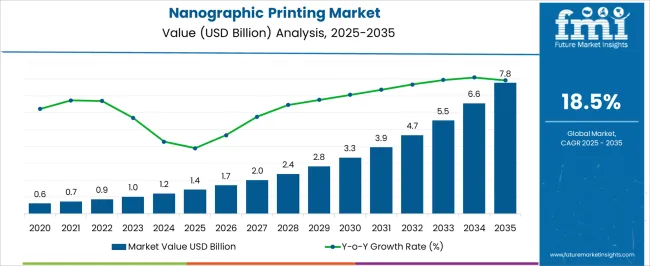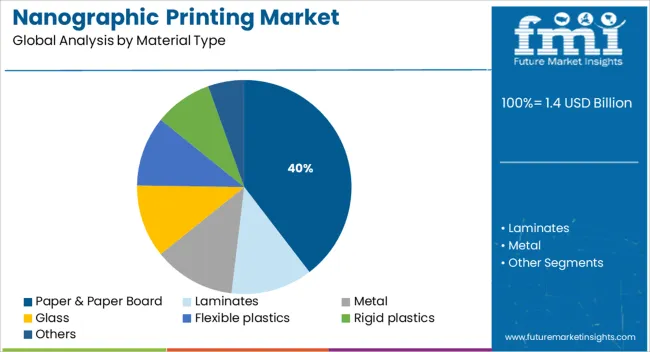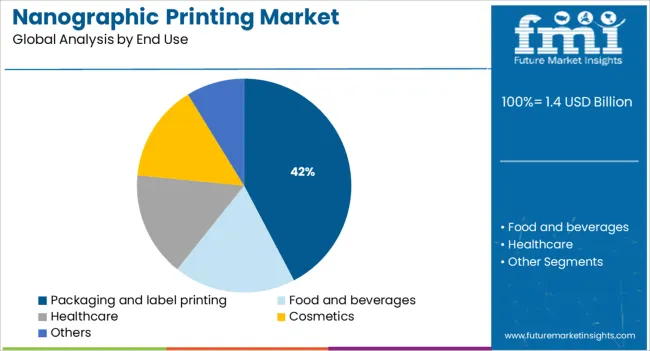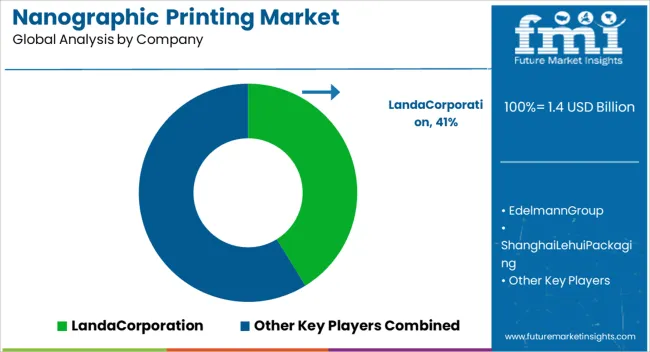The Nanographic Printing Market is estimated to be valued at USD 1.4 billion in 2025 and is projected to reach USD 7.8 billion by 2035, registering a compound annual growth rate (CAGR) of 18.5% over the forecast period.

| Metric | Value |
|---|---|
| Nanographic Printing Market Estimated Value in (2025E) | USD 1.4 billion |
| Nanographic Printing Market Forecast Value in (2035F) | USD 7.8 billion |
| Forecast CAGR (2025 to 2035) | 18.5% |
The nanographic printing market is witnessing accelerated adoption as industries seek cost-effective and sustainable alternatives to conventional analog and digital printing technologies. Nanographic printing, built upon nanotechnology-enabled ink dispersion and advanced substrate compatibility, has emerged as a game-changer due to its ability to combine the quality of offset printing with the flexibility of digital workflows.
Its application is being widely explored in sectors requiring short-run and variable data printing, particularly where turnaround speed and print accuracy are critical. The use of nanometric pigment particles ensures vibrant color reproduction while minimizing ink consumption, aligning well with evolving environmental regulations and waste reduction mandates.
Technological advancements in printing press architectures and substrate adaptability are further expanding nanographic printing’s relevance across commercial and packaging domains Looking forward, growing investments in print automation, on-demand packaging solutions, and sustainable label printing practices are expected to open new opportunities for nanographic printing technologies across both mature and emerging economies.
The market is segmented by Material Type and End Use and region. By Material Type, the market is divided into Paper & Paper Board, Laminates, Metal, Glass, Flexible plastics, Rigid plastics, and Others. In terms of End Use, the market is classified into Packaging and label printing, Food and beverages, Healthcare, Cosmetics, and Others. Regionally, the market is classified into North America, Latin America, Western Europe, Eastern Europe, Balkan & Baltic Countries, Russia & Belarus, Central Asia, East Asia, South Asia & Pacific, and the Middle East & Africa.

The paper and paper board segment is projected to hold 39.6% of the nanographic printing market revenue share in 2025, making it the leading material type in this space. The segment’s dominance is being driven by the high demand for sustainable and recyclable substrates in both commercial and packaging applications. Paper-based materials are widely preferred due to their printability, surface consistency, and adaptability with nanographic ink dispersion mechanisms.
These substrates provide optimal absorption for water-based nano inks, enabling sharp image rendering and fast drying times without compromising on environmental compliance. The shift toward eco-conscious packaging, combined with regulatory restrictions on plastic-based materials, has encouraged the increased use of paper and paper board across industries.
Additionally, advancements in substrate coating technologies have enabled paper materials to support high-resolution nanographic prints even in high-volume production runs As manufacturers continue to innovate toward biodegradable and recyclable packaging formats, the reliance on paper and paper board in nanographic printing is expected to grow steadily.

The packaging and label printing segment is anticipated to account for 42.3% of the nanographic printing market revenue share in 2025, reflecting its significant contribution as the leading end-use sector. Growth in this segment is being driven by the escalating demand for short-run, high-quality packaging solutions that support brand personalization and regulatory compliance.
Nanographic printing technology enables precise color reproduction and variable data printing on a wide range of packaging materials, making it highly suitable for food, beverage, pharmaceutical, and consumer goods labeling. The ability to run high-speed, on-demand print jobs without the need for traditional printing plates has allowed packaging firms to reduce turnaround times and inventory costs.
Moreover, the push for sustainable and recyclable packaging formats has aligned well with the water-based ink systems used in nanographic printing As brands increasingly adopt digital packaging strategies to enhance customer engagement and meet evolving compliance requirements, nanographic printing is poised to play a central role in the transformation of the packaging and label printing landscape.
Recent years have witnessed a rise in demand for printing owing to increase in manufacturing industry across the globe. This resulted in an increase in demand for digital printing which is expected to grow over the forecasted period. Nanographic printing is expected to grow on the backdrop of markets using Nano technology.
Owing to the higher quality of printing and more efficiency for working speed, the market for Nanographic printing has seen a substantial growth and is expected to grow. Demand for Nanographic printing is continuously growing with technology manufacturers are eying towards burgeoning market of printing for packaging.
Some of the key factors which are creating an appreciation for the growth potential of Nanographic printing are as follows: water based ink having Nano pigments which can measure tens of nanometers for diameter.
Nanographic printing market holds anticipation due to the drivers having upward growth of the printing industry. Significant change in the lifestyle and convenience of emerging economies across the globe has triggered the growth potential for Nanographic printing market.
Customers are mainly focusing on quality of the print which has been considerably provided by Nanographic printing technology.
In addition, it was observed that the increase in disposable income of developing countries is some of the key drivers for the dynamic growth of Nanographic printing market.
Moreover, Rapid industrialization and recent innovations in the field of printing technology are other factors fueling demand for Nanographic printing globally.
The growth of the global Nanographic printing market is moderately hampered by higher cost for printing ink as a raw material. Global Nanographic printing market also faces problems related to increasing stringent regulations and norms for the printing industry.
The Nanographic printing market in North America region are to remain supreme for the highest revenue growth as compared to markets in other regions. Nanographic printing market in China and India are expected to have considerable growth in terms of revenue owing to technological advancements in the field of printing industry for these developing economies.
Furthermore, the growth of Nanographic printing market in other parts of Asia Pacific is expected to be driven by increasing disposable income and spending power among consumers in the countries of this region.
Nanographic printing market in Western Europe is expected to witness above average growth, with Germany, the UK, Italy, and France ranking high regarding demand for Nanographic printing.
Eastern Europe is also expected to have anticipation in the growth potential in Russia and Poland for Nanographic printing market. Latin America would also have a presence for Nanographic printing market and is expected to grow at a notable rate. The economic development in Brazil is projected to have a positive impact on the market for Nanographic printing.
The Nanographic printing market in the MEA region is expected to witness a significant increase in revenue contribution from sales in GCC countries and South Africa. Japan is also expected to continue with the stagnant growth for Nanographic printing market over the forecast period.
The global Nanographic printing market is segmented on the basis of region such as:

Presently Nanographic printing is majorly offered by Landa Corporation Ltd, which is based in Israel. Owing to its benefits and high quality of printing, the global printing market is expected to become more competitive, with more players focusing on R & D and coming up with better and faster printers.
The research report presents a comprehensive assessment of the market and contains thoughtful insights, facts, historical data, and statistically supported and industry-validated market data. It also contains projections using a suitable set of assumptions and methodologies. The research report provides analysis and information according to categories such as market segments, geographies, type of product and applications.
The global nanographic printing market is estimated to be valued at USD 1.4 billion in 2025.
The market size for the nanographic printing market is projected to reach USD 7.8 billion by 2035.
The nanographic printing market is expected to grow at a 18.5% CAGR between 2025 and 2035.
The key product types in nanographic printing market are paper & paper board, laminates, metal, glass, flexible plastics, rigid plastics and others.
In terms of end use, packaging and label printing segment to command 42.3% share in the nanographic printing market in 2025.






Our Research Products

The "Full Research Suite" delivers actionable market intel, deep dives on markets or technologies, so clients act faster, cut risk, and unlock growth.

The Leaderboard benchmarks and ranks top vendors, classifying them as Established Leaders, Leading Challengers, or Disruptors & Challengers.

Locates where complements amplify value and substitutes erode it, forecasting net impact by horizon

We deliver granular, decision-grade intel: market sizing, 5-year forecasts, pricing, adoption, usage, revenue, and operational KPIs—plus competitor tracking, regulation, and value chains—across 60 countries broadly.

Spot the shifts before they hit your P&L. We track inflection points, adoption curves, pricing moves, and ecosystem plays to show where demand is heading, why it is changing, and what to do next across high-growth markets and disruptive tech

Real-time reads of user behavior. We track shifting priorities, perceptions of today’s and next-gen services, and provider experience, then pace how fast tech moves from trial to adoption, blending buyer, consumer, and channel inputs with social signals (#WhySwitch, #UX).

Partner with our analyst team to build a custom report designed around your business priorities. From analysing market trends to assessing competitors or crafting bespoke datasets, we tailor insights to your needs.
Supplier Intelligence
Discovery & Profiling
Capacity & Footprint
Performance & Risk
Compliance & Governance
Commercial Readiness
Who Supplies Whom
Scorecards & Shortlists
Playbooks & Docs
Category Intelligence
Definition & Scope
Demand & Use Cases
Cost Drivers
Market Structure
Supply Chain Map
Trade & Policy
Operating Norms
Deliverables
Buyer Intelligence
Account Basics
Spend & Scope
Procurement Model
Vendor Requirements
Terms & Policies
Entry Strategy
Pain Points & Triggers
Outputs
Pricing Analysis
Benchmarks
Trends
Should-Cost
Indexation
Landed Cost
Commercial Terms
Deliverables
Brand Analysis
Positioning & Value Prop
Share & Presence
Customer Evidence
Go-to-Market
Digital & Reputation
Compliance & Trust
KPIs & Gaps
Outputs
Full Research Suite comprises of:
Market outlook & trends analysis
Interviews & case studies
Strategic recommendations
Vendor profiles & capabilities analysis
5-year forecasts
8 regions and 60+ country-level data splits
Market segment data splits
12 months of continuous data updates
DELIVERED AS:
PDF EXCEL ONLINE
Printing Paper Market Size and Share Forecast Outlook 2025 to 2035
Printing Machinery Market Size and Share Forecast Outlook 2025 to 2035
Printing Toners Market Size and Share Forecast Outlook 2025 to 2035
Printing Supplies Market Analysis by Application, Technology, and Region Forecast Through 2035
Printing Plate Market
3D Printing Industry Analysis in Middle East Size and Share Forecast Outlook 2025 to 2035
3D Printing Ceramics Market Size and Share Forecast Outlook 2025 to 2035
3D Printing Metal Market Size and Share Forecast Outlook 2025 to 2035
3D Printing in Aerospace and Defense Market Analysis - Size, Share, and Forecast Outlook 2025 to 2035
3D Printing Market Size and Share Forecast Outlook 2025 to 2035
3D Printing in Automotive Market Size and Share Forecast Outlook 2025 to 2035
3D Printing In Construction Market Size and Share Forecast Outlook 2025 to 2035
3D Printing Dental Devices Market Growth - Trends & Forecast 2025 to 2035
3D Printing Photopolymers Market Trends, Analysis & Forecast by Material, Application and Region through 2035
3D Printing Materials Market Analysis by Material Type, Form, Application, and Region from 2025 to 2035
Market Positioning & Share in the 3D Printing Metal Industry
Evaluating 3D Printing Filament Market Share & Provider Insights
4D Printing Market
Pad Printing Machine Market Insights - Growth & Demand 2025 to 2035
Microprinting Market Size and Share Forecast Outlook 2025 to 2035

Thank you!
You will receive an email from our Business Development Manager. Please be sure to check your SPAM/JUNK folder too.
Chat With
MaRIA